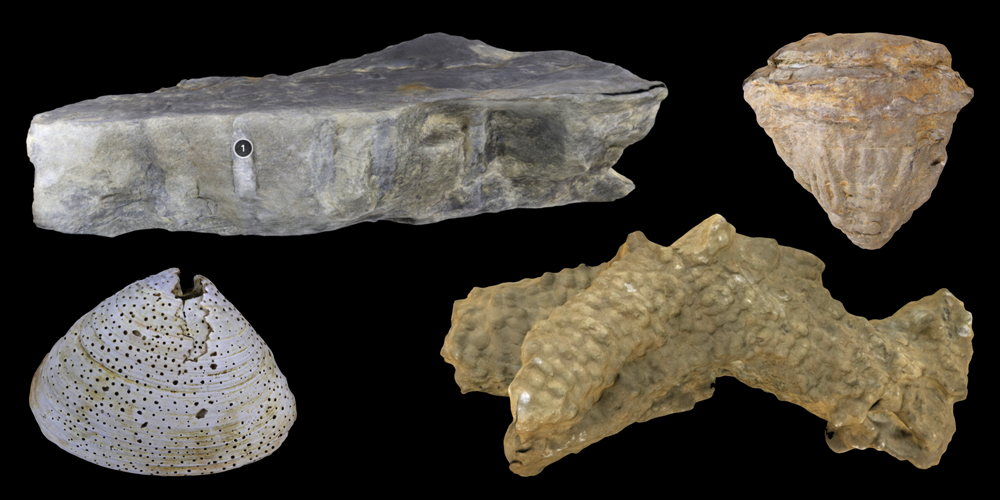This virtual collection was last curated by Jaleigh Pier on August 20, 2019. Each model is licensed under a Creative Commons Attribution-ShareAlike 4.0 International License. Unless otherwise indicated, each model was created by Emily Hauf using specimens at the Paleontological Research Institution, Ithaca, New York.
Dwelling traces (Domichnia)
Trace fossil specimens of Skolithos, which are vertical burrows (PRI 80026). This rock was collected from the Devonian Enfield Formation of Tompkins County, New York. Specimen is part of the research collection of the Paleontological Research Institution, Ithaca, New York. Rock is approximately 15 cm in length.
Conostichus ornatus, a dwelling trace fossil that was possibly made by a sea anemone (PRI 76854). This specimen is from the Pennsylvanian of Clay County, Kentucky and is part of the research collections of the Paleontological Research Institution, Ithaca, New York. The longest dimension of the specimen is approximately 9.5 cm.
Conostichus ornatus, a dwelling trace fossil that was possibly made by a sea anemone (PRI 76854). This specimen, which was cut in half to show internal structure, is from the Pennsylvanian of Clay County, Kentucky and is part of the research collections of the Paleontological Research Institution, Ithaca, New York. The diameter of the specimen is approximately 9.5 cm.
Fossil specimen of the burrow trace fossil Halymenites major from the Cretaceous of Colorado (PRI 76769). Specimen is from the collections of the Paleontological Research Institution, Ithaca, New York. Length of specimen is approximately 17.5 cm.
The burrow trace fossil Diplocraterion sp. from the Pennsylvanian Hale Formatoin of Washington County, Arkansas (PRI 76773). Specimen is from the collections of the Paleontological Research Institution, Ithaca, New York. Length of specimen (not including surrounding rock matrix) is approximately 6 cm.
Modern specimen of the bivalve Spisula solidissima showing numerous holes made by boring sponges (T-210). These dwelling traces are called Entobia. Specimen is from Cape May County, New Jersey and is part of the teaching collection of the Paleontological Research Institution, Ithaca, New York. Width of clam shell is approximately 12.5 cm.
A worn fossil specimen of the bivalve Mercenaria mercenaria that has been extensively bored into by the sponge Clionia sulphurea and encrusted by the scleractinian coral Astrangia danae. Specimen is from the research collections of the Paleontological Research Institution, Ithaca, New York. Length of shell is approximately 8.5 cm.
Modern specimen of the tulip snail Fasciolaria tulipa with numerous small holes created by the boring sponge Cliona celata. These dwelling traces are called Entobia. Specimen is from Florida and is part of the teaching collections of the Paleontological Research Institution, Ithaca, New York. Length of shell is approximately 10 cm.
Fossil specimen of the gastropod Conus yaquensis from the upper Pliocene Tamiami Formation (Pinecrest Beds) of Sarasota County, Florida (PRI 70658). The small holes on the specimen were produced by boring sponges; these types of trace fossils are called Entobia. Specimen is from the collections of the Paleontological Research Institution.
Individuals of the trace fossil Teredolites, which are borings made in fossil wood (PRI 61842); specimen is from the Paleocene Lopez de Bertodano Fm. of Seymour Island, Antarctica. Fossil is part of the research collections of the Paleontological Research Institution, Ithaca, New York. Length of rock is approximately 16.5 cm.



